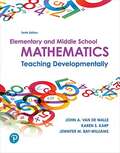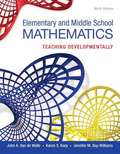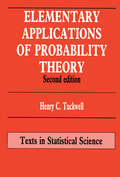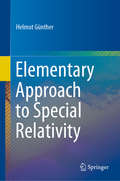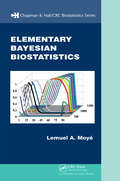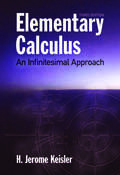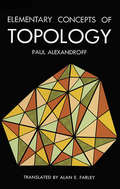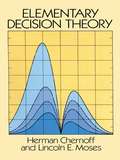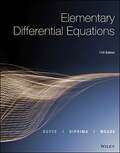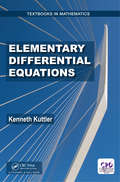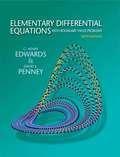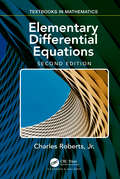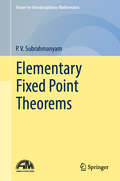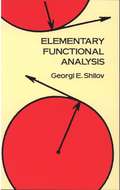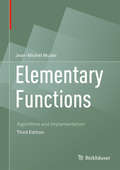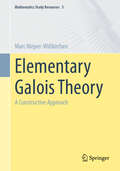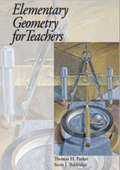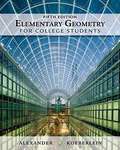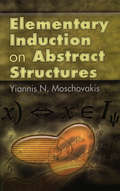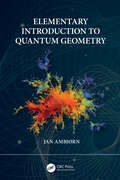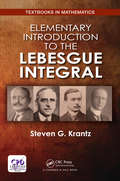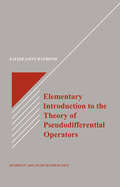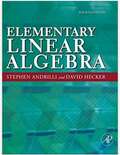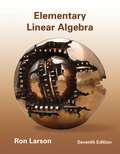- Table View
- List View
Elementary And Middle School Mathematics: Teaching Developmentally
by John Van de Walle Karen Karp Jennifer Bay-WilliamsThis handy reference is particularly useful for elementary teachers who are changing grade levels and special education teachers who teach multiple grades and multiple ability levels. Guide teachers to help all PreK-8 learners make sense of mathematics Elementary and Middle School Mathematics: Teaching Developmentally illustrates how children learn mathematics, and then shows pre-service teachers the most effective methods of teaching PreK-8 math through hands-on, problem-based activities. As you engage with the activities, you'll boost your own knowledge of the math and learn concrete, developmentally appropriate ways to incorporate problem-based tasks in your classroom. Examples of real student work and new common challenges and misconception tables help you visualize good mathematics instruction and assessment that supports and challenges all learners. An important reference to consult throughout your teaching career, this book reflects the Common Core State Standards and NCTM’s Principles to Actions, as well as current research and coverage of the latest teaching technology.
Elementary And Middle School Mathematics: Teaching Developmentally
by John A. Van de Walle Karen S. Karp Jennifer M. Bay-WilliamsElementary and Middle School Mathematics: Teaching Developmentally, Professional Development Edition provides unparalleled depth of ideas and discussion to help mathematics coaches and other teacher leaders foster teachers' understanding of the mathematics they will teach and the most effective teaching methods for the various mathematics topics. This text reflects the philosophy of the NCTM and Common Core State Standards and the benefits of problem-based mathematics instruction. The Coach/Teacher Leader Guide to this Book and Activities Matrix that appear at the front of the book and Professional Learning Opportunities sections, Coach/Teacher Leader Considerations boxes, and PDToolkit boxes that appear at the end of each chapter ensure this book is a valuable resource for all educators who facilitate mathematics professional development and support students making sense of mathematics.
Elementary Applications of Probability Theory (Chapman And Hall/crc Texts In Statistical Science Ser. #32)
by Henry C. TuckwellThis book provides a clear and straightforward introduction to applications of probability theory with examples given in the biological sciences and engineering.The first chapter contains a summary of basic probability theory. Chapters two to five deal with random variables and their applications. Topics covered include geometric probability, estimation of animal and plant populations, reliability theory and computer simulation. Chapter six contains a lucid account of the convergence of sequences of random variables, with emphasis on the central limit theorem and the weak law of numbers. The next four chapters introduce random processes, including random walks and Markov chains illustrated by examples in population genetics and population growth. This edition also includes two chapters which introduce, in a manifestly readable fashion, the topic of stochastic differential equations and their applications.
Elementary Approach to Special Relativity
by Helmut GüntherThis book presents an alternative representation of Einstein's Special Theory of Relativity, which makes Special Relativity much more comprehensible. Moreover, one will come across a fundamental relationship between the Special Theory of Relativity and the mechanics of space lattice. In all previous formulations, the Einsteinian special principle of relativity, in one or the other form is used as the starting point for Special Relativity. In correspondence to this principle, one takes it as granted apriori, that all observers independent of their uniform motion to each other measure one and the same propagation velocity of a light signal. This book is thought of as a lecture for physicists, mathematicians and computer scientists and concentrates on the students of these fields. The book should reach a broad circle of interested readers from the fields of natural sciences and philosophy and provide and invigorating experience for engineers.
Elementary Bayesian Biostatistics (Chapman & Hall/CRC Biostatistics Series)
by Lemuel A. MoyeBayesian analyses have made important inroads in modern clinical research due, in part, to the incorporation of the traditional tools of noninformative priors as well as the modern innovations of adaptive randomization and predictive power. Presenting an introductory perspective to modern Bayesian procedures, Elementary Bayesian Biostatistics explo
Elementary Calculus: An Infinitesimal Approach (Dover Books on Mathematics)
by H. Jerome KeislerThis first-year calculus book is centered around the use of infinitesimals, an approach largely neglected until recently for reasons of mathematical rigor. It exposes students to the intuition that originally led to the calculus, simplifying their grasp of the central concepts of derivatives and integrals. The author also teaches the traditional approach, giving students the benefits of both methods.Chapters 1 through 4 employ infinitesimals to quickly develop the basic concepts of derivatives, continuity, and integrals. Chapter 5 introduces the traditional limit concept, using approximation problems as the motivation. Later chapters develop transcendental functions, series, vectors, partial derivatives, and multiple integrals. The theory differs from traditional courses, but the notation and methods for solving practical problems are the same. The text suggests a variety of applications to both natural and social sciences.
Elementary Concepts of Topology
by Paul AlexandroffAlexandroff's beautiful and elegant introduction to topology was originally published in 1932 as an extension of certain aspects of Hilbert's Anschauliche Geometrie. The text has long been recognized as one of the finest presentations of the fundamental concepts, vital for mathematicians who haven't time for extensive study and for beginning investigators.The book is not a substitute for a systematic text, but an unusually useful intuitive approach to the basic concepts. Its aim is to present these concepts in a clear, elementary fashion without sacrificing their profundity or exactness and to give some indication of how they are useful in increasingly more areas of mathematics. The author proceeds from the basics of set-theoretic topology, through those topological theorems and questions which are based upon the concept of the algebraic complex, to the concept of Betti groups which binds together central topological theories in a whole and upon which applications of topology largely rest.Wholly consistent with current investigations, in which a larger and larger part of topology is governed by the concept of homology, the book deals primarily with the concepts of complex, cycle, and homology. It points the way toward a systematic and entirely geometrically oriented theory of the most general structures of space.First English translation, prepared for Dover by Alan E. Farley. Preface by David Hilbert. Author's Foreword. Index. 25 figures.
Elementary Decision Theory (Dover Books on Mathematics)
by Lincoln E. Moses Herman Chernoff"The text is very clearly written [with] many illustrative examples and exercises [and] should be considered by those instructors who would like to introduce a more modern (and a more logical) approach in a basic course in statistics." --Journal of the American Statistical AssociationThis volume is a well-known, well-respected introduction to a lively area of statistics. Professors Chernoff and Moses bring years of professional expertise as classroom teachers to this straightforward approach to statistical problems. And happily, for beginning students, they have by-passed involved computational reasonings which would only confuse the mathematical novice.Developed from nine years of teaching statistics at Stanford, the book furnishes a simple and clear-cut method of exhibiting the fundamental aspects of a statistical problem. Beginners will find this book a motivating introduction to important mathematical notions such as set, function and convexity. Examples and exercises throughout introduce new topics and ideas.The first seven chapters are recommended for beginning courses in the basic ideas of statistics and require only a knowledge of high school math. These sections include material on data processing, probability and random variables, utility and descriptive statistics, uncertainty due to ignorance of the state of nature, computing Bayes strategies and an introduction to classical statistics. The last three chapters review mathematical models and summarize terminology and methods of testing hypotheses. Tables and appendixes provide information on notation, shortcut computational formulas, axioms of probability, properties of expectations, likelihood ratio test, game theory, and utility functions.Authoritative, yet elementary in its approach to statistics and statistical theory, this work is also concise, well-indexed and abundantly equipped with exercise material. Ideal for a beginning course, this modestly priced edition will be especially valuable to those interested in the principles of statistics and scientific method.
Elementary Differential Equations
by William E. Boyce Richard C. DiPrimaElementary Differential Equations, 11th Edition is written from the viewpoint of the applied mathematician, whose interest in differential equations may sometimes be quite theoretical, sometimes intensely practical, and often somewhere in between. <p><p>The authors have sought to combine a sound and accurate (but not abstract) exposition of the elementary theory of differential equations with considerable material on methods of solution, analysis, and approximation that have proved useful in a wide variety of applications. While the general structure of the book remains unchanged, some notable changes have been made to improve the clarity and readability of basic material about differential equations and their applications. <p><p> In addition to expanded explanations, the 11th edition includes new problems, updated figures and examples to help motivate students. The program is primarily intended for undergraduate students of mathematics, science, or engineering, who typically take a course on differential equations during their first or second year of study. The main prerequisite for engaging with the program is a working knowledge of calculus, gained from a normal two or three semester course sequence or its equivalent. Some familiarity with matrices will also be helpful in the chapters on systems of differential equations.
Elementary Differential Equations (Textbooks in Mathematics)
by Kenneth Kuttler<p>Elementary Differential Equations presents the standard material in a first course on differential equations, including all standard methods which have been a part of the subject since the time of Newton and the Bernoulli brothers. The emphasis in this book is on theory and methods and differential equations as a part of analysis. <p>Differential equations is worth studying, rather than merely some recipes to be used in physical science. The text gives substantial emphasis to methods which are generally presented first with theoretical considerations following. Essentially all proofs of the theorems used are included, making the book more useful as a reference. <p>The book mentions the main computer algebra systems, yet the emphasis is placed on MATLAB and numerical methods which include graphing the solutions and obtaining tables of values. <p>Featured applications are easily understood. Complete explanations of the mathematics and emphasis on methods for finding solutions are included.</p>
Elementary Differential Equations With Boundary Value Problems
by Howard Anton William TrenchWritten in a clear and accurate language that students can understand, Trench's new book minimizes the number of explicitly stated theorems and definitions. Instead, he deals with concepts in a conversational style that engages students. He includes more than 250 illustrated, worked examples for easy reading and comprehension. One of the book's many strengths is its problems, which are of consistently high quality. Trench includes a thorough treatment of boundary-value problems and partial differential equations and has organized the book to allow instructors to select the level of technology desired. This has been simplified by using symbols, C and L, to designate the level of technology. C problems call for computations and/or graphics, while L problems are laboratory exercises that require extensive use of technology. Informal advice on the use of technology is included in several sections and instructors who prefer not to emphasize technology can ignore these exercises without interrupting the flow of material.
Elementary Differential Equations with Boundary Value Problems (Sixth Edition)
by David E. Penney C. Henry EdwardsThe Sixth Edition of this widely adopted book remains the same classic differential equations text it's always been, but has been polished and sharpened to serve both instructors and students even more effectively.Edwards and Penney teach students to first solve those differential equations that have the most frequent and interesting applications. Precise and clear-cut statements of fundamental existence and uniqueness theorems allow understanding of their role in this subject. A strong numerical approach emphasizes that the effective and reliable use of numerical methods often requires preliminary analysis using standard elementary techniques.
Elementary Differential Equations: Applications, Models, and Computing (Textbooks in Mathematics)
by Charles Roberts Jr.<p>Elementary Differential Equations, Second Edition is written with the knowledge that there has been a dramatic change in the past century in how solutions to differential equations are calculated. However, the way the topic has been taught in introductory courses has barely changed to reflect these advances, which leaves students at a disadvantage. This second edition has been created to address these changes and help instructors facilitate new teaching methods and the latest tools, which includes computers. <p>The text is designed to help instructors who want to use computers in their classrooms. It accomplishes this by emphasizing and integrating computers in teaching elementary or ordinary differential equations. Many examples and exercises included in the text require the use of computer software to solve problems. It should be noted that since instructors use their own preferred software, this book has been written to be independent of any specific software package. <p>Features: <p> <li>Focuses on numerical methods and computing to generate solutions <li>Features extensive coverage of nonlinear differential equations and nonlinear systems <li>Includes software programs to solve problems in the text which are located on the author's website <li>Contains a wider variety of non-mathematical models than any competing textbook</li> <p>This second edition is a valuable, up-to-date tool for instructors teaching courses about differential equations. It serves as an excellent introductory textbook for undergraduate students majoring in applied mathematics, computer science, various engineering disciplines and other sciences. They also will find that the textbook will aide them greatly in their professional careers because of its instructions on how to use computers to solve equations.</p>
Elementary Fixed Point Theorems (Forum for Interdisciplinary Mathematics)
by P. V. SubrahmanyamThis book provides a primary resource in basic fixed-point theorems due to Banach, Brouwer, Schauder and Tarski and their applications. Key topics covered include Sharkovsky’s theorem on periodic points, Thron’s results on the convergence of certain real iterates, Shield’s common fixed theorem for a commuting family of analytic functions and Bergweiler’s existence theorem on fixed points of the composition of certain meromorphic functions with transcendental entire functions. Generalizations of Tarski’s theorem by Merrifield and Stein and Abian’s proof of the equivalence of Bourbaki–Zermelo fixed-point theorem and the Axiom of Choice are described in the setting of posets. A detailed treatment of Ward’s theory of partially ordered topological spaces culminates in Sherrer fixed-point theorem. It elaborates Manka’s proof of the fixed-point property of arcwise connected hereditarily unicoherent continua, based on the connection he observed between set theory and fixed-point theory via a certain partial order. Contraction principle is provided with two proofs: one due to Palais and the other due to Barranga. Applications of the contraction principle include the proofs of algebraic Weierstrass preparation theorem, a Cauchy–Kowalevsky theorem for partial differential equations and the central limit theorem. It also provides a proof of the converse of the contraction principle due to Jachymski, a proof of fixed point theorem for continuous generalized contractions, a proof of Browder–Gohde–Kirk fixed point theorem, a proof of Stalling's generalization of Brouwer's theorem, examine Caristi's fixed point theorem, and highlights Kakutani's theorems on common fixed points and their applications.
Elementary Functional Analysis
by Georgi E. ShilovIn this introductory work on mathematical analysis, the noted mathematician Georgi E. Shilov begins with an extensive and important chapter on the basic structures of mathematical analysis: linear spaces, metric spaces, normed linear spaces, Hilbert spaces, and normed algebras. The standard models for all these spaces are sets of functions (hence the term "functional analysis"), rather than sets of points in a finite-dimensional space.Chapter 2 is devoted to differential equations, and contains the basic theorems on existence and uniqueness of solutions of ordinary differential equations for functions taking values in a Banach space. The solution of the linear equation with constant (operator) coefficients is written in general form in terms of the exponential of the operator. This leads, in the finite-dimensional case, to explicit formulas not only for the solutions of first-order equations, but also to the solutions of higher-order equations and systems of equations. The third chapter presents a theory of curvature for curve in a multidimensional space.The final two chapters essentially comprise an introduction to Fourier analysis. In the treatment of orthogonal expansions, a key role is played by Fourier series and the various kinds of convergence and summability for such series. The material on Fourier transforms, in addition to presenting the more familiar theory, also deals with problems in the complex domain, in particular with problems involving the Laplace transform.Designed for students at the upper-undergraduate or graduate level, the text includes a set of problems for each chapter, with hints and answers at the end of the book.
Elementary Functions
by Jean-Michel MullerThis textbook presents the concepts and tools necessary to understand, build, and implement algorithms for computing elementary functions (e. g. , logarithms, exponentials, and the trigonometric functions). Both hardware- and software-oriented algorithms are included, along with issues related to accurate floating-point implementation. This third edition has been updated and expanded to incorporate the most recent advances in the field, new elementary function algorithms, and function software. After a preliminary chapter that briefly introduces some fundamental concepts of computer arithmetic, such as floating-point arithmetic and redundant number systems, the text is divided into three main parts. Part I considers the computation of elementary functions using algorithms based on polynomial or rational approximations and using table-based methods; the final chapter in this section deals with basic principles of multiple-precision arithmetic. Part II is devoted to a presentation of "shift-and-add" algorithms (hardware-oriented algorithms that use additions and shifts only). Issues related to accuracy, including range reduction, preservation of monotonicity, and correct rounding, as well as some examples of implementation are explored in Part III. Numerous examples of command lines and full programs are provided throughout for various software packages, including Maple, Sollya, and Gappa. New to this edition are an in-depth overview of the IEEE-754-2008 standard for floating-point arithmetic; a section on using double- and triple-word numbers; a presentation of new tools for designing accurate function software; and a section on the Toom-Cook family of multiplication algorithms. The techniques presented in this book will be of interest to implementers of elementary function libraries or circuits and programmers of numerical applications. Additionally, graduate and advanced undergraduate students, professionals, and researchers in scientific computing, numerical analysis, software engineering, and computer engineering will find this a useful reference and resource. PRAISE FOR PREVIOUS EDITIONS "[T]his book seems like an essential reference for the experts (which I'm not). More importantly, this is an interesting book for the curious (which I am). In this case, you'll probably learn many interesting things from this book. If you teach numerical analysis or approximation theory, then this book will give you some good examples to discuss in class. " -- MAA Reviews (Review of Second Edition) "The rich content of ideas sketched or presented in some detail in this book is supplemented by a list of over three hundred references, most of them of 1980 or more recent. The book also contains some relevant typical programs. " -- Zentralblatt MATH (Review of Second Edition) "I think that the book will be very valuable to students both in numerical analysis and in computer science. I found [it to be] well written and containing much interesting material, most of the time disseminated in specialized papers published in specialized journals difficult to find. " -- Numerical Algorithms (Review of First Edition)
Elementary Galois Theory: A Constructive Approach (Mathematics Study Resources #3)
by Marc Nieper-WißkirchenWhy is the squaring of the circle, why is the division of angles with compass and ruler impossible? Why are there general solution formulas for polynomial equations of degree 2, 3 and 4, but not for degree 5 or higher? This textbook deals with such classical questions in an elementary way in the context of Galois theory. It thus provides a classical introduction and at the same time deals with applications. The point of view of a constructive mathematician is consistently adopted: To prove the existence of a mathematical object, an algorithmic construction of that object is always given. Some statements are therefore formulated somewhat more cautiously than is classically customary; some proofs are more elaborately conducted, but are clearer and more comprehensible. Abstract theories and definitions are derived from concrete problems and solutions and can thus be better understood and appreciated. The material in this volume can be covered in a one-semester lecture on algebra right at the beginning of mathematics studies and is equally suitable for first-year students at the Bachelor's level and for teachers. The central statements are already summarised and concisely presented within the text, so the reader is encouraged to pause and reflect and can repeat content in a targeted manner. In addition, there is a short summary at the end of each chapter, with which the essential arguments can be comprehended step by step, as well as numerous exercises with an increasing degree of difficulty. The translation was done with the help of artificial intelligence. A subsequent human revision was done primarily in terms of content.
Elementary Geometry For Teachers
by Thomas H. Parker Scott J. BaldridgeThis is a mathematics textbook for teachers that focuses on the parts of the K-8 curriculum involving measurement and geometry; it also includes a chapter on data, probability and statistics. It is a sequel to our text Elementary Mathematics for Teachers (EMT), which focused on arithmetic.
Elementary Geometry for College Students
by Daniel C. Alexander Geralyn M. KoeberleinBuilding on the success of its first four editions, the Fifth Edition of this market-leading text covers the important principles and real-world applications of plane geometry, with a new chapter on locus and concurrence and by adding 150-200 new problems including 90 designed to be more rigorous. Strongly influenced by both NCTM and AMATYC standards, the text takes an inductive approach that includes integrated activities and tools to promote hands-on application and discovery.
Elementary Induction on Abstract Structures
by Yiannis N. MoschovakisHailed by the Bulletin of the American Mathematical Society as "easy to use and a pleasure to read," this research monograph is recommended for students and professionals interested in model theory and definability theory. The sole prerequisite is a familiarity with the basics of logic, model theory, and set theory.The author, Professor of Mathematics at UCLA and Emeritus Professor of Mathematics,University of Athens, Greece, begins with a focus on the theory of inductive and hyperelementary sets. Subsequent chapters advance to acceptable structures and countable acceptable structures, concluding with the main result of the Barwise-Gandy-Moschovakis theory, which is the key to many applications of abstract recursion theory. Exercises at the end of each chapter form an integral part of the text, offering examples useful to the development of the general theory and outlining the theory's extensions.
Elementary Introduction to Quantum Geometry
by Jan AmbjornThis graduate textbook provides an introduction to quantum gravity, when spacetime is two-dimensional. The quantization of gravity is the main missing piece of theoretical physics, but in two dimensions it can be done explicitly with elementary mathematical tools, but it still has most of the conceptional riddles present in higher dimensional (not yet known) quantum gravity. It provides an introduction to a very interdisciplinary field, uniting physics (quantum geometry) and mathematics (combinatorics) in a non-technical way, requiring no prior knowledge of quantum field theory or general relativity. Using the path integral, the chapters provide self-contained descriptions of random walks, random trees and random surfaces as statistical systems where the free relativistic particle, the relativistic bosonic string and two-dimensional quantum gravity are obtained as scaling limits at phase transition points of these statistical systems. The geometric nature of the theories allows one to perform the path integral by counting geometries. In this way the quantization of geometry becomes closely linked to the mathematical fields of combinatorics and probability theory. By counting the geometries, it is shown that the two-dimensional quantum world is fractal at all scales unless one imposes restrictions on the geometries. It is also discussed in simple terms how quantum geometry and quantum matter can interact strongly and change the properties both of the geometries and of the matter systems. It requires only basic undergraduate knowledge of classical mechanics, statistical mechanics and quantum mechanics, as well as some basic knowledge of mathematics at undergraduate level. It will be an ideal textbook for graduate students in theoretical and statistical physics and mathematics studying quantum gravity and quantum geometry. Key features: Presents the first elementary introduction to quantum geometry Explores how to understand quantum geometry without prior knowledge beyond bachelor level physics and mathematics. Contains exercises, problems and solutions to supplement and enhance learning
Elementary Introduction to the Lebesgue Integral (Textbooks in Mathematics)
by Steven G. KrantzIt is important and useful to have a text on the Lebesgue theory that is accessible to bright undergraduates. This is such a text. Going back to the days of Isaac Newton and Gottfried Wilhelm von Leibniz, and even to Newton's teacher Isaac Barrow, the integral has been a mainstay of mathematical analysis. The integral is a device for amalgamating information. It is a powerful and irreplaceable tool. The text concentrates on the real line. The student will be familiar with the real numbers and will be comfortable internalizing the new ideas of measure theory in that context. In addition to having copious examples and numerous figures, this book includes a Table of Notation and a Glossary.
Elementary Introduction to the Theory of Pseudodifferential Operators (Studies In Advanced Mathematics Ser. #3)
by Xavier Saint RaymondIn the 19th century, the Fourier transformation was introduced to study various problems of partial differential equations. Since 1960, this old tool has been developed into a well-organized theory called microlocal analysis that is based on the concept of the pseudo-differential operator. This book provides the fundamental knowledge non-specialists need in order to use microlocal analysis. It is strictly mathematical in the sense that it contains precise definitions, statements of theorems and complete proofs, and follows the usual method of pure mathematics. The book explains the origin of the theory (i.e., Fourier transformation), presents an elementary construcion of distribution theory, and features a careful exposition of standard pseudodifferential theory. Exercises, historical notes, and bibliographical references are included to round out this essential book for mathematics students; engineers, physicists, and mathematicians who use partial differential equations; and advanced mathematics instructors.
Elementary Linear Algebra
by David Hecker Stephen AndrilliElementary Linear Algebra develops and explains in careful detail the computational techniques and fundamental theoretical results central to a first course in linear algebra. This highly acclaimed text focuses on developing the abstract thinking essential for further mathematical study. <p><p>The authors give early, intensive attention to the skills necessary to make students comfortable with mathematical proofs. The text builds a gradual and smooth transition from computational results to general theory of abstract vector spaces. It also provides flexbile coverage of practical applications, exploring a comprehensive range of topics.
Elementary Linear Algebra
by Ron LarsonThe cornerstone of ELEMENTARY LINEAR ALGEBRA is the authors' clear, careful, and concise presentation of material--written so that readers can fully understand how mathematics works. This program balances theory with examples, applications, and geometric intuition for a complete, step-by-step learning system. Featuring a new design that highlights the relevance of the mathematics and improves readability, the Seventh Edition also incorporates new conceptual Capstone exercises that reinforce multiple concepts in each section. Data and applications reflect current statistics and examples to engage users and demonstrate the link between theory and practice.
